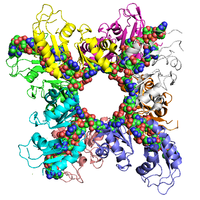
Photo from wikipedia
Emerging protein–protein interaction (PPI) modulators have brought out exciting ability as therapeutics in human diseases, but its clinical translation has been greatly hampered by the limited affinity. Inspired by the… Click to show full abstract
Emerging protein–protein interaction (PPI) modulators have brought out exciting ability as therapeutics in human diseases, but its clinical translation has been greatly hampered by the limited affinity. Inspired by the homodimerize structure of antibody, the homodimerization contributes hugely to generating the optimized affinity is conjectured. Herein, a statistical‐mechanics‐theory‐guided method is established to quantize the affinity of ligands with different topologies through analyzing the change of enthalpy and the loss of translational and rotational entropies. A peptide modulator for p53‐MDM2 termed CPAP is used to homodimerize connecting, and this simple homodimerization can significantly increase the affinity. To realize the cellular internalization and tumor accumulation, DimerCPAP and MonoCPAP are nanoengineered into gold(I)‐CPAP supermolecule by the aurophilic interaction‐driven self‐assembly. Nano‐DimerCPAP potently suppressed tumor growth in lung cancer allograft model and a patient‐derived xenograft model in more action than Nano‐MonoCPAP, while keeping a favorable drug safety profile. This work not only presents a physico‐mechanical method for calculating the affinity of PPI modulators, but also provides a simple yet robust homodimerization strategy to optimize the affinity of PPI modulators.
Journal Title: Advanced Science
Year Published: 2022
Link to full text (if available)
Share on Social Media: Sign Up to like & get
recommendations!